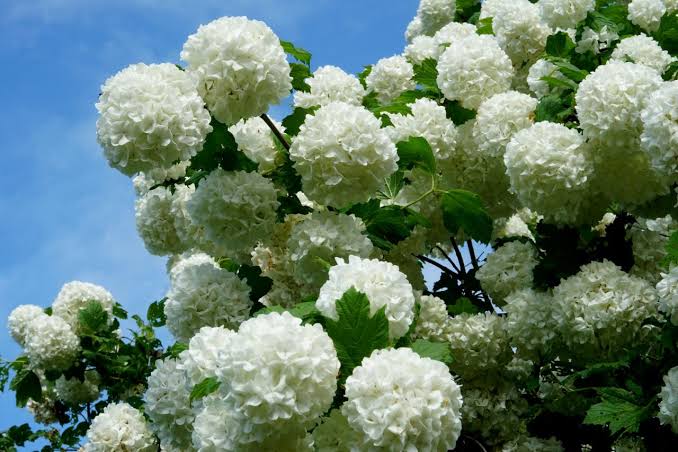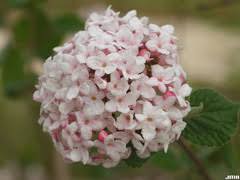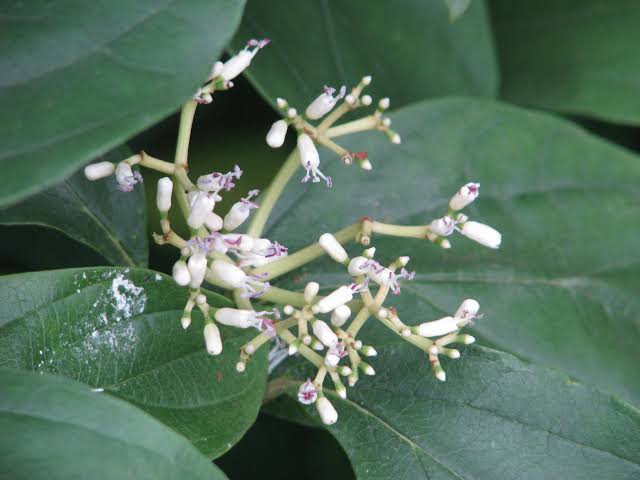Overview
Viburnums, in the honeysuckle plant family, comprise a diverse group of approximately 150 species of shrubs and small trees. Several species viburnums shine in the home landscape with either especially attractive flowers or fruit. Viburnums may be deciduous or evergreen, with their handsome foliage contributing to the garden’s charms. The intensely fragrant flowers of many viburnums attest to their honeysuckle family heritage, and fruiting varieties delight birds with autumn and winter berries.
Viburnums are characterized by opposite, simple or palmately lobed leaves and clusters of small, often fragrant white or pink flowers, followed by red, blue or black berries. Viburnums are versatile in the landscape and many works well when planted to form a viburnum hedge or screen. There exist many varieties of viburnums and they vary in their height, spread and style of flower but are similar in preferring sun to part shade and in being disease and pest resistant. In this article, get to understand various types of viburnum varieties and their growing profile.
Varieties/Types Of Viburnum
1. Burkwood Viburnum
Burkwood is a densely-branched, multi-stemmed, semi-evergreen shrub with ovate, glossy, dark green leaves that turn maroon in fall. Burkwood viburnum typically grows 8-10 feet tall and 5-7 feet wide. It features fragrant white flowers tinged with pink arranged in snowball clusters. Flowers are followed by pendulous clusters of red berry-like drupes which ripen with black color in mid to late summer.

Plant Profile/Facts
- Common Name: Burkwood viburnum
- Plant Type: Deciduous Shrub
- Family: Adoxaceae
- Genus: Viburnum
- Native Range:
- Hardiness Zones: 4 to 8
- Height: 8 to 10 feet
- Spread: 5 to 7 feet
- Bloom Time: April
- Bloom Description: Fragrant white flowers tinged with pink
- Sunlight Sun: Full sun to part shade
- Water: Medium
- Maintenance: Low
- Flower: Showy, Fragrant
- Attracts: Birds, Butterflies
- Tolerance: Drought
2. Cinnamomum-Leaved Viburnum
Cinnamomum-leaved viburnum is a large evergreen shrub with large, feathery, deep green, narrowly oval leaves with three prominent veins. Broad clusters of small dull white flowers in early summer are followed by blue-black berries. The plant grows in moderately fertile, humus-rich, well-drained soil.

Plant Profile/Facts
- Common Name: Cinnamon-leaved viburnum
- Plant Type: Deciduous Shrub
- Family: Adoxaceae, Caprifoliaceae
- Genus: Viburnum
- Soil Type: Rich, well-drained
- Soil PH: Acid, Neutral, Alkaline
- Habit: Bushy
- Leaf : Broad and evergreen
- Native Range: China
- Hardiness Zones: 7 to 9
- Height: 10 to 12 feet
- Bloom Time: Late spring/Early Summer
- Bloom Description: Fragrant pink-white
- Sunlight Sun: Full sun to part shade
- Water: Medium
- Maintenance: Low
- Flower: Showy, Fragrant
- Attracts: Birds, Butterflies
- Tolerance: Drought
- Diseases: Leaf spot and honey fungus
- Pests: Aphids
3. Viburnum tinus (Laurustinus)
Viburnum tinus is a vigorous bushy evergreen shrub noted for its eye-catching flower clusters, colorful berries and leathery foliage. Opening from pale pink buds from winter to mid spring, masses of tiny, fragrant, white flower clusters are elegantly held above the foliage. The dense evergreen foliage of ovate, glossy dark green leaves makes Laurustinus an excellent choice for mixed shrub borders or low screens.

Plant Profile/Facts
- Common Name: Laurustinus
- Plant Type: Deciduous Shrub
- Family: Adoxaceae, Caprifoliaceae
- Genus: Viburnum
- Soil Type: Rich, well-drained
- Soil PH: Acid, Neutral, Alkaline
- Habit: Bushy
- Leaf : Broad and evergreen
- Height: Around 240cm
- Bloom Time: Late spring/Early Summer
- Bloom Description: white
- Sunlight Sun: Full sun to part shade
- Water: Medium
- Maintenance: Low
- Flower: Showy, Fragrant
- Attracts: Birds, Butterflies
- Tolerance: Dear, Drought
- Diseases: Leaf spot and honey fungus
- Pests: Aphids
Also Read: Different Types of Hydrangeas
4. Viburnum Dentatum (Southern Arrowwood)
Viburnum dentatum also referred to as arrowwood is a small shrub, native to the Eastern United States and Canada. It is upright, rounded, multi-stemmed, deciduous shrub which typically matures to 6-10 feet tall with a corresponding spread, but may reach a height of 15 feet in optimum growing conditions. In spring, small, white flowers mature in flat-topped clusters up to 4 inches wide. It also produces a bluish-black drupe that matures in late summer and early fall. This shrub makes a greet screen, informal hedge and is useful in groupings and masses or as filler in the border.

Plant Profile/Facts
- Common Name: Southern arrowwood, downy arrowwood or arrowwood viburnum
- Botanical Name: Viburnum dentatum
- Plant Type: Deciduous Shrub
- Family: Adoxaceae
- Genus: Viburnum
- Native: North America
- Soil Type: Rich, well-drained
- Soil PH: Acid, Neutral, Alkaline
- Height: More than 8 feet
- Bloom Time: Late spring/Early Summer
- Bloom Description: White
- Sunlight Sun: Full sun to part shade
- Water: Medium
- Maintenance: Low
- Flower: Showy, Fragrant
- Attracts: Birds, Butterflies
- Tolerance: Dear, Drought
- Diseases: Leaf spot and honey fungus
- Pests: Aphids
5. Snowball Bush Viburnum
Snowball viburnum is a multi-stemmed deciduous shrub with erect and arching stems growing to 12 feet tall and wide. In the late spring, snowball bush viburnum will be covered masses of pure white, snowball-like flower clusters, with leaves that turn purplish-red before dropping in the fall.

Plant Profile/Facts
- Common Name: Snowball bush, snowball viburnum, eastern snowball
- Botanical Name: Viburnum opulus
- Plant Type: Deciduous Shrub
- Family: Adoxaceae
- Genus: Viburnum
- Native: North America, Europe, Central Asia
- Soil Type: Rich, well-drained
- Soil PH: Acid, Neutral, Alkaline
- Height: More than 9 feet
- Bloom Time: Late spring/Early Summer
- Bloom Description: White
- Sunlight Sun: Full sun to part shade
- Water: Medium
- Maintenance: Low
- Flower: Showy, Fragrant
- Attracts: Birds, Butterflies
- Tolerance: Dear, Drought
- Diseases: Leaf spot and honey fungus
- Pests: Aphids
6. Viburnum Lentago (Nannyberry)
Viburnum lentago also referred to as Nannyberry or sheepberry is a large shrub reaching 15-20 feet high, known for its dark, lustrous green leaves which turn maroon-red in the fall. Also, there are ivory flowers that appear in late spring, flat-topped inflorescence as wide as the hand-palm. Each group has numerous tiny blossoms. These flowers develop into a colorful mixture different colored fruits, some light green, others pale yellow or red-pink and all in the same cluster.

Plant Profile/Facts
- Common Name: Nannyberry, sheepberry
- Botanical Name: Viburnum lentago
- Plant Type: Deciduous Shrub
- Family: Adoxaceae
- Genus: Viburnum
- Native: North America, Europe
- Soil Type: Rich, well-drained
- Soil PH: Acid, Neutral, Alkaline
- Height: More than 9 feet
- Bloom Time: Late spring/Early Summer
- Bloom Description: White
- Sunlight Sun: Full sun to part shade
- Water: Medium
- Maintenance: Low
- Flower: Showy, Fragrant
- Attracts: Birds, Butterflies
- Tolerance: Dear, Drought
- Diseases: Leaf spot and honey fungus
- Pests: Aphids
Also Read: Flowering Shrubs For Your Yard
7. Leatherleaf Viburnum
Viburnum rhytidophyllum also referred to as leatherleaf viburnum is an attractive shrub native to Asia. This vigorous coarsely textured evergreen shrub has an upright habit and 8-inch long, lustrous, deeply veined oval leaves with dark blue-green surfaces and pale green undersides. The leaf stems are fuzzy brown. While the creamy white flowers light up the spring landscape, this species offers no fall color change. Bright red berries appear after the flowers fade, gradually changing to shiny black. The berries attract birds and last well into December.

Plant Profile/Facts
- Common Name: Leatherleaf viburnum
- Botanical Name: Viburnum rhytidophyllum
- Plant Type: Deciduous Shrub
- Family: Adoxaceae
- Genus: Viburnum
- Native: Asia (Central and west China)
- Soil Type: Rich, well-drained
- Soil PH: Acid, Neutral, Alkaline
- Height: More than 9 feet
- Growth Rate:Moderate
- Bloom Time: Late spring/Early Summer
- Bloom Description: White
- Sunlight Sun: Full sun to part shade
- Water: Medium
- Maintenance: Low
- Flower: Showy, Fragrant
- Attracts: Birds, Butterflies
- Tolerance: Dear, Drought
- Diseases: Leaf spot and honey fungus
- Pests: Aphids
8. Koreanspice Viburnum
The koreanspice viburnum is a medium sized deciduous shrub that is popular for fragrant white spring flowers as well as their good fall color. They tend to grow to between 3 and 5 feet tall and wide, but they can reach as high as 8 feet in ideal growing conditions. The 4-inch leaves are ridged and deep green. In autumn, they turn deep red to purple.
Koreanspice viburnum plants produce 2 to 3 inch wide clusters of small flowers that begin pink and open to white in early to mid spring. The flowers give off a rich scent that is similar to spice cake. These flowers are followed by blue-black berries. This shrub is a perfect choice as specimen, in a shrub border and as a foundation plant.

Plant Profile/Facts
- Common Name: Korean spice viburnum or Koreanspice viburnum
- Botanical Name: Viburnum carlesii
- Plant Type: Deciduous Shrub
- Family: Adoxaceae
- Genus: Viburnum
- Native: Asia (Korea and Japan)
- Soil Type: Rich, well-drained
- Soil PH: Acid, Neutral, Alkaline
- Height: 3-5 feet
- Growth Rate: Moderate, slow
- Bloom Time: Late spring/Early Summer
- Bloom Description: White
- Sunlight Sun: Full sun to part shade
- Water: Medium
- Maintenance: Low
- Flower: Showy, Fragrant
- Attracts: Birds, Butterflies
- Tolerance: Dear, Drought
- Diseases: Leaf spot and honey fungus
- Pests: Aphids
Also Read: How to grow and care for Oakleaf Hydrangeas
9. Henry’s Viburnum
Henry’s viburnum is an evergreen shrub and grows between 5-7 feet height and width in full sun or partial shade area. This shrub blooms fragrant white cluster flowers in late spring to early summer and attract bees, butterflies and birds as well.

Plant Profile/Facts
- Common Name: Henry’s viburnum
- Botanical Name: Viburnum henryi
- Plant Type: Deciduous Shrub
- Family: Adoxaceae
- Genus: Viburnum
- Native: North America
- Soil Type: Rich, well-drained
- Soil PH: Acid, Neutral, Alkaline
- Height: 3-5 feet
- Growth Rate: Moderate, slow
- Bloom Time: Late spring/Early Summer
- Bloom Description: White
- Sunlight Sun: Full sun to part shade
- Water: Medium
- Maintenance: Low
- Flower: Showy, Fragrant
- Attracts: Birds, Butterflies
- Tolerance: Dear, Drought
- Diseases: Leaf spot and honey fungus
- Pests: Aphids
10. David Viburnum
David viburnum is a low, compact, evergreen shrub with large, glossy, oval leaves. Each leaf is deeply veined lengthwise with three curved lines. It produces showy clusters of creamy white flowers in spring followed in late summer and autumn by oval blue fruits. This shrub makes an effective hedge or natural screen and can be planted in borders or along foundations.

Plant Profile/Facts
- Common Name: David viburnum
- Botanical Name: Viburnum davidii
- Plant Type: Deciduous Shrub
- Family: Adoxaceae
- Genus: Viburnum
- Native: Asia (West China)
- Soil Type: Rich, well-drained
- Soil PH: Acid, Neutral, Alkaline
- Height: 3-5 feet
- Growth Rate: Moderate, slow
- Bloom Time: Late spring/Early Summer
- Bloom Description: White
- Sunlight Sun: Full sun to part shade
- Water: Medium
- Maintenance: Low
- Flower: Showy, Fragrant
- Attracts: Birds, Butterflies
- Tolerance: Dear, Drought
- Diseases: Leaf spot and honey fungus
- Pests: Aphids
11. Wayfaring Tree (Viburnum lantana)
Viburnum lantana commonly referred to as the wayfarer or wayfaring tree is native to central and Western Europe, northwest Africa and southwestern Asia. Wayfaring tree is a perennial shrub with multiple stems growing from 8 to 15 feet high forming a dense rounded shape. The thick, dark green leaves, white spring flowers and beautiful clusters of red to yellow to black berries add to the ornamental appeal.

Plant Profile/Facts
- Common Name: Wayfaring tree or Wayfarer
- Botanical Name: Viburnum lantana
- Plant Type: Deciduous Shrub
- Family: Adoxaceae
- Genus: Viburnum
- Native: Asia
- Soil Type: Rich, well-drained
- Soil PH: Acid, Neutral, Alkaline
- Height: 8-15 feet
- Growth Rate: Moderate, slow
- Bloom Time: Late spring/Early Summer
- Bloom Description: White
- Sunlight Sun: Full sun to part shade
- Water: Medium
- Maintenance: Low
- Flower: Showy, Fragrant
- Attracts: Birds, Butterflies
- Tolerance: Dear, Drought
- Diseases: Leaf spot and honey fungus
- Pests: Aphids
12. Viburnum cylindricum
Viburnum cylindricum shrub is about 10-20 feet tall. It makes a large shrub with largish narrow oblong evergreen leaves and wonderful tubular white flowers with lilac stamens spilling out from the corolla during August and September. Viburnum cylindricum is found in the Himalayas, Burma, Thailand, China and Malaysia.

Plant Profile/Facts
- Common Name: Viburnum cylindricum
- Botanical Name: Viburnum cylindricum
- Plant Type: Deciduous Shrub
- Family: Adoxaceae
- Genus: Viburnum
- Native: Asia
- Soil Type: Rich, well-drained
- Soil PH: Acid, Neutral, Alkaline
- Height: 10-20 feet
- Growth Rate: Moderate, slow
- Bloom Time: Late spring/Early Summer
- Bloom Description: White
- Sunlight Sun: Full sun to part shade
- Water: Medium
- Maintenance: Low
- Flower: Showy, Fragrant
- Attracts: Birds, Butterflies
- Tolerance: Dear, Drought
- Diseases: Leaf spot and honey fungus
- Pests: Aphids